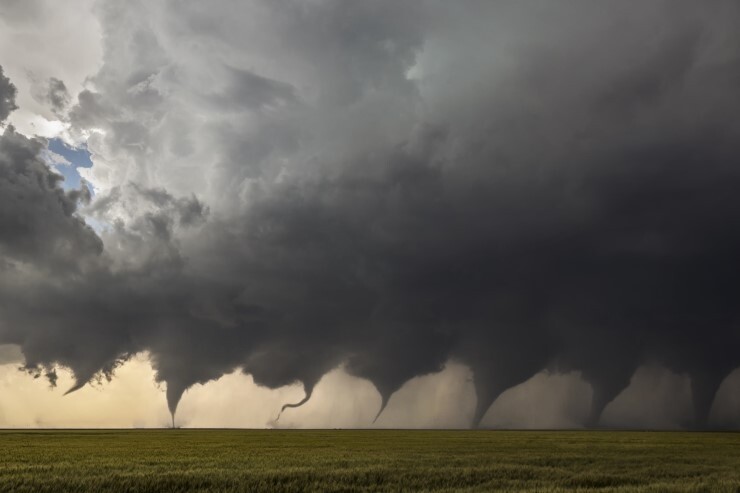
A composite of eight photos depicting the formation of a tornado.
(Image credit – Jason Weingart, CC BY-SA 4.0)

A composite of eight photos depicting the formation of a tornado.
(Image credit – Jason Weingart, CC BY-SA 4.0)
This month, the National Academies hosted a workshop
The effort stems from the White House’s latest R&D budget priorities memorandum
Addressing the workshop, White House Office of Science and Technology Policy Director Kelvin Droegemeier said
Explaining the importance of Earth system predictability research, the White House R&D priorities memo states, “Knowing the extent to which components of the Earth system are practicably predictable — from individual thunderstorms to long-term global change — is vitally important for physical understanding of the Earth system, assessing the value of prediction results, guiding federal investments, developing effective policy, and improving predictive skill.”
At the workshop, Droegemeier emphasized the distinction between the act of predicting a phenomenon and research on the predictability of that phenomenon, defining predictability as “a measure of whether, and to what extent, an event or behavior of a system is practically predictable.”
Drawing on his background
Observing that while meteorologists were able to make weather predictions before having a theoretical framework for atmosphere predictability, he said Lorenz’s work offered an important bound that shaped the direction of later research.
Droegemeier noted that in his own research career he sought to push the limits of severe storm forecasts through the Center for the Analysis and Prediction of Storms he co-founded at the University of Oklahoma in 1989. “Lorenz thought that things like thunderstorms were not predictable for more than maybe 15 minutes, but there were maybe some aspects of storms like rotation, which was a stabilizing effect, that we thought might have greater predictability,” he said.
More generally, Droegemeier said that although the R&D priorities memo focuses on Earth system predictability, understanding the practical limits of predictability is important in a broad range of disciplines, such as modeling the spread of invasive species or infectious diseases, citing recent work
The final session
Duane Waliser, chief scientist of the Earth Science and Technology Directorate at NASA’s Jet Propulsion Laboratory, advocated using a systems engineering approach to rethink current collaborative mechanisms.
“At present, we probably do have this sort of collaborative system of systems. You could call it our Earth System Prediction System 1.0. And it has developed over the last 50 years in a somewhat ad hoc and opportunistic manner,” Waliser said. “And so, would there be value in stepping back and architecting a hypothetical system? What would it look like, designing from scratch?” he asked, suggesting that even a sketch of an idealized system could help identify research priorities.
Paula Bontempi, the incoming dean of the University of Rhode Island Graduate School of Oceanography, commented on the related problem posed by the “compartmentalization” of Earth science disciplines, saying that as a biologist she laments how the Earth system is often only associated with matters of weather and climate. She said one approach to bringing more disciplines to bear on questions of predictability would be to craft carefully worded funding solicitations that create opportunities for different teams of scientists to work together, adding that ideally such efforts would receive new money rather than siphoning resources from other research activities.
Waleed Abdalati, director of the Cooperative Institute for Research in Environmental Sciences at the University of Colorado Boulder, spoke to the challenge of getting individual agencies to work toward a common goal, especially in times of constrained budgets.
“The way budgets are done now, the way agency directives and mandates are structured, we’re in a situation where we’re never really getting past the sum-of-the-parts approach as opposed to the whole,” he said. “I feel like agencies really need to be empowered to surrender some of that narrower focus in the interest of prioritizing a collective objective. They need to be liberated to do more than just play in the sandbox together. They need to build the sandbox together.”
Abdalati continued that absent new resources, agencies may be forced to prioritize external, interagency activities over internal capabilities. He pointed to the latest Earth science decadal survey
In a similar vein, University of Washington atmospheric scientist Chris Bretherton argued that “conflicting U.S. agency priorities” are one of the main challenges to improving the Earth system research program. As an example, he suggested the proliferation of competing modeling systems in the U.S. is attributable to the desire of various funding agencies to maintain their own capabilities. Bretherton also advocated for developing shared, concrete research objectives. “We can’t just be thinking we’re going to improve our understanding of prediction and predictability in the Earth system. We can’t have kitchen sink goals,” he said.
He continued, “It’s much better to have goals like dynamical [El Niño Southern Oscillation] forecasts, or projecting the adaptability and resilience of coral reefs over the next 50 years, or making probability maps that land will be inundated by a 30 year flood before 2050. Those kinds of things are very interdisciplinary tasks that naturally bring communities together.”